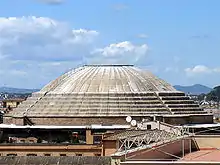Roman architectural revolution
The Roman architectural revolution, also known as the concrete revolution,[2] was the widespread use in Roman architecture of the previously little-used architectural forms of the arch, vault, and dome. For the first time in history, their potential was fully exploited in the construction of a wide range of civil engineering structures, public buildings, and military facilities. These included amphitheatres, aqueducts, baths, bridges, circuses, dams, roads, and temples.

A crucial factor in this development that saw a trend to monumental architecture was the invention of Roman concrete (also called opus caementicium), which led to the liberation of the shape from the dictate of the traditional materials of stone and brick.[3]
For the first time in recorded history we find evidence of an interest in the shapes of the space contained strong enough to outweigh the functional logic of the masonry masses that contained it. There was nothing new in the employment of curvilinear or polygonal forms, as such...But in so far as such buildings incorporated curvilinear or polygonal rooms and corridors, the shapes of these were determined by the form of the building as a whole, not by any aesthetic principle.[3]
The development of Roman architecture, however, did not remain limited to these new forms and materials. An unrelated process of architectural innovation continued unabated, which, although less conspicuous, proved their usefulness for solving structural problems and found their way permanently into Western architecture, such as the lintel arch, the independent corbel, and the metal-tie.[4]
.jpg.webp)
During the Age of Augustus, almost the entire city of Rome was rebuilt causing an influx of craftsman and architects from all across Europe. Emperor Augustus aimed to develop new ideas in the construction of his buildings that would forever defy the limits that were ever thought possible. The Mausoleum in Campus Martius was one of the major monuments built by Augustus during his reign that was made almost entirely of concrete using updated construction techniques. The concrete is used to in concentric rings that support the structure of the building like walls. The Theatre of Marcellus was another concrete triumph completed during the Age of Augustus, dedicated to the nephew of the emperor. The brick-faced concrete structure construction started under the reign of Julius Caesar but was completed under Augustus. It was this building that shows the integration of new concrete building techniques of Augustus's architects as opposed to those of Caesar.[5] The Theatre of Marcellus uses a variety of materials that aid in the growth of the concrete revolution using readily available volcanic stones such as Tuscolo tuff and Tufo Lionato as aggregates in pozzolanic concretes.
These newly concocted recipes for concrete provided durability to walls and barrelled vaults as well as a unique aesthetic appeal. The integrated stone and masonry design illustrate a refinement that came with the concrete revolution as a result of the new techniques and styles developed under Augustus. The craftsmanship of the Theatre Marcellus demonstrated a skilled employment as well as rigorous technical supervision.[6]
Footnotes
- The Roman Pantheon: The Triumph of Concrete
- DeLaine 1990, p. 407; Rook 1992, pp. 18f.; Gardner 2005, p. 170
- Ward-Perkins 1956, p. 219
- DeLaine 1990, p. 407
- Sear, Frank (1983). Roman Architecture. Ithaca, New York: Conell University Press. pp. 49-68.
- Jackson, M.D. "Building Materials of the Theatre of Marcellus, Rome". Archaeometry. 53 (4). doi:10.1111/j.1475-4754.2010.00570.x.
References
- Ball, Larry (2003), The Domus Aurea and the Roman Architectural Revolution, Cambridge University Press, ISBN 978-0-521-82251-0
- Brown, Frank (1961), Roman Architecture, George Braziller, pp. 25–31, ISBN 978-08076-0156-3
- DeLaine, Janet (1990), "Structural Experimentation: The Lintel Arch, Corbel and Tie in Western Roman Architecture", World Archaeology, 21 (3): 407–424 (407), doi:10.1080/00438243.1990.9980116
- Gardner, Helen (2005), Gardner's Art Through The Ages: The Western Perspective, Wadsworth Publishing, p. 170, ISBN 978-0-495-00479-0
- Jackson, M. D.; Ciancio Rossetto, P.; Kosso, C. K.; Buonfiglio, M.; Marra, F. (2011), "Building Materials of the Theatre of Marcellus, Rome", Archaeometry, 53 (4): 728–742
- Lechtman, H. N.; Hobbs, L. W. (1987), "Roman Concrete and the Roman Architectural Revolution", Ceramics and Civilization, 3, pp. 81–128
- MacDonald, William (1982), The Architecture of the Roman Empire (2nd ed.), Yale University Press, pp. 38–46, 141–146, 167–183, ISBN 978-0-300-02819-5
- McKay, A. G. (1975), Houses, Villas and Palaces in the Roman World, The Johns Hopkins University Press, pp. 130–131
- Ward-Perkins, J. B. (1956), "Nero's Golden House", Antiquity, 30 (120): 209–219 (217–19), doi:10.1017/S0003598X00026843
- Ward-Perkins, J. B. (1981), Roman Imperial Architecture (2nd ed.), The Yale University, pp. 97–120, ISBN 978-0-300-05292-3
- Rook, Tony (1992), Roman Baths in Britain, Osprey Publishing, pp. 18–19, ISBN 978-0-7478-0157-3
- Sear, Frank (1982), Roman Architecture, Cornell University Press, pp. 101–102, ISBN 978-0-8014-9245-7
- Sear, Frank (1983), Roman Architecture, Cornell University Press, pp. 49–85, ISBN 978-08014-9245-7
Further reading
- Adam, Jean-Pierre (2005), Roman Building. Materials and Techniques, Routledge, ISBN 0-203-98436-6
- Lancaster, Lynne (2005), Concrete Vaulted Construction in Imperial Rome. Innovations in Context, Cambridge University Press, ISBN 978-0-511-16068-4
- MacDonald, William (1958), "Some Implications of Later Roman Construction", The Journal of the Society of Architectural Historians, Society of Architectural Historians, 17 (4): 2–8, doi:10.2307/987944, JSTOR 987944
External links
- Traianus – Technical investigation of Roman public works
- The Roman Pantheon: The Triumph of Concrete
- Fikret Yegul: Roman Concrete
- Roman aqueducts: Types of Opus Caementicium walls